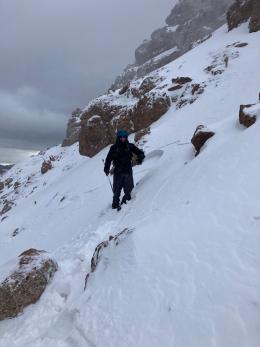This is Dave Zinn with pre-season avalanche, weather and event information for the Gallatin National Forest Avalanche Center on Wednesday, November 6th. This information is sponsored by The Friends of the Avalanche Center. We will update this bulletin as conditions warrant.
Mountain temperatures on Wednesday morning are in the single digits to teens F, with 10-25 mph winds blowing from the west to the north. The mountains near Bozeman received 10-15” of new snow in the last 24 hours, with 4” in Big Sky, 1” in West Yellowstone and Cooke City, and none in Island Park. Lingering flurries will end this morning, and skies will be sunny for the remainder of the week as high temperatures work their way into the mid-30s to low-40s F.
All Regions
This week’s storm changed the avalanche picture. Backcountry travelers will find a layered snowpack capable of producing avalanches across the forecast area in most mid to upper-elevation terrain. Storm totals since Saturday in the mountains around Bozeman and Big Sky are 20-24” (1.3-1.8” of snow water equivalent-SWE), with 10-14” near West Yellowstone and Island Park (1.1-1.4” SWE) and 7” (0.7” SWE) in Cooke City. Visit our weather log for a daily breakdown. As Alex discussed in a short video, the snow on the ground is likely the foundation of this season’s snowpack.
Expect and prepare for avalanches within the new and wind-drifted snow. Slides will be likely at the tail end of this week’s storm, especially around Bozeman and Big Sky, where the most snow fell and winds gusted 40-60 mph. Without additional loading, stability will improve throughout the week. However, uncertainty is high this time of year as we learn the specifics of a new snowpack. Employ an information-gathering mindset and a healthy distrust for steep snow-covered slopes. Signs of instability, such as recent avalanche activity, shooting cracks and collapsing, are red flags and reasons to avoid avalanche terrain. Dig a quick snowpit to assess for instability when obvious signs are not present.
Early season avalanches on the Sphinx last weekend (photos and details), outside the advisory area on Emigrant Peak on Monday (photo and details), along with an observation of signs of instability on Mount Blackmore from Saturday (observation) are clear indicators that avalanche season is here. Whether hunting, skiing, riding, climbing or sledding, if you cross a steep slope where snow is deep enough to cover the grass and rocks, you may be able to trigger a slide. Carry rescue gear (beacon, shovel and probe) and follow safe travel procedures in and around avalanche terrain.
Public observations are incredibly valuable as we develop a picture of the season's snowpack. Please contribute to our community’s knowledge by submitting your observations, and look through our observation page for additional information before your next backcountry adventure.
We are preparing for winter and will collect snowpack information as the snow builds up. If you have avalanche, snowpack or weather observations to share, please submit them via our website, email (mtavalanche@gmail.com), phone (406-587-6984), or Instagram (#gnfacobs).
Upcoming Avalanche Education and Events
Our education calendar is full of awareness lectures and field courses. Check it out: Events and Education Calendar
Wednesday, November 13, 4-8 p.m., Montana State University Snow and Avalanche Workshop. Open to the public.
Thursday, November 14, 6:30-9 p.m., Earn Your Turns Night with Spark R&D at the Rialto. Fundraiser for the Friends of the GNFAC.
Thursday, November 21, 6-7 p.m., Free Avalanche Awareness for Families and Friends at Story Mill Community Center.
Friends Fall Powder Blast Fundraiser!
Thanks to your donations and a successful Powder Blast Fundraiser, The Friends of the Avalanche raised 75% of the fall fundraising goal. We are working to finish off the remaining $19,000 to fund free and low-cost avalanche education, beacon checkers at trailheads, beacon parks for public training, weather stations and support avalanche center operations. So, if you missed the party last week and want to support avalanche outreach and education, you can still contribute to the fall fundraising campaign HERE.
Read accident reports from previous early season accidents before you venture to the snowy hills. This accident report from October 2012 in the northern Bridger Range, and this report from the tragic fatality six years ago in early October are reminders of the potential consequences of even a small avalanche.


